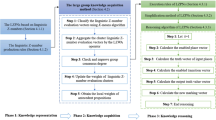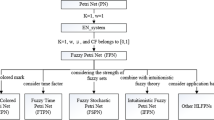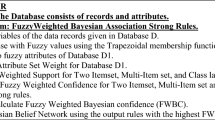Abstract
Fuzzy Petri nets (FPNs) are a promising modeling tool for knowledge representation and reasoning. As a new type of FPNs, bipolar fuzzy Petri nets (BFPNs) are developed in this article to overcome the shortcomings and improve the performance of traditional FPNs. In order to depict expert knowledge more accurately, the BFPN model adopts bipolar fuzzy sets (BFSs), which are characterized by the satisfaction degree to property and the satisfaction degree to its counter property, to represent knowledge parameters. Because of the increasing scale of expert systems, a concurrent hierarchical reasoning algorithm is introduced to simplify the structure of BFPNs and reduce the computation complexity of knowledge reasoning algorithm. In addition, a large group expert weighting method is proposed for knowledge acquisition by taking experts’ non-cooperative behaviors into account. A realistic case of risk index evaluation system is presented to show the effectiveness and practicality of the proposed BFPNs. The result shows that the new BFPN model is feasible and efficient for knowledge representation and acquisition.





Similar content being viewed by others
References
Liu HC, Liu L, Lin QL, Liu N (2013) Knowledge acquisition and representation using fuzzy evidential reasoning and dynamic adaptive fuzzy Petri nets. IEEE Trans Cybern 43(3):1059–1072
Yeung DS, Ysang ECC (1998) A multilevel weighted fuzzy reasoning algorithm for expert systems. IEEE Trans Syst Man Cybern Part A Syst Hum 28(2):149–158
Liu HC, Lin QL, Mao LX, Zhang ZY (2013) Dynamic adaptive fuzzy Petri nets for knowledge representation and reasoning. IEEE Trans Syst Man Cybern Syst 43(6):1399–1410
Yeung DS, Tsang ECC (1994) Improved fuzzy knowledge representation and rule evaluation using fuzzy Petri nets and degree of subsethood. Int J Intell Syst 9(12):1083–1100
Liu Y, Li X (2019) The application of an amended FCA method on knowledge acquisition and representation for interpreting meteorological services. J Ambient Intell Human Comput. https://doi.org/10.1007/s12652-019-01305-2
Looney CG (1988) Fuzzy Petri nets for rule-based decision-making. IEEE Trans Syst Man Cybern 18(1):178–183
Chen SM, Ke JS, Chang JF (1990) Knowledge representation using fuzzy Petri nets. IEEE Trans Knowl Data Eng 2(3):311–319
Zhou KQ, Mo LP, Jin J, Zain AM (2019) An equivalent generating algorithm to model fuzzy Petri net for knowledge-based system. J Intell Manuf 30(4):1831–1842
Yeung DS, Tsang ECC (1994) Fuzzy knowledge representation and reasoning using Petri nets. Expert Syst Appl 7(2):281–289
Liu HC, Lin QL, Ren ML (2013) Fault diagnosis and cause analysis using fuzzy evidential reasoning approach and dynamic adaptive fuzzy Petri nets. Comput Ind Eng 66(4):899–908
Kiaei I, Lotfifard S (2020) Fault section identification in smart distribution systems using multi-source data based on fuzzy Petri nets. IEEE Trans Smart Grid 11(1):74–83
Shi H, Wang L, Li XY, Liu HC (2019) A novel method for failure mode and effects analysis using fuzzy evidential reasoning and fuzzy Petri nets. J Ambient Intell Human Comput. https://doi.org/10.1007/s12652-019-01262-w
Li XY, Xiong Y, Duan CY, Liu HC (2019) Failure mode and effect analysis using interval type-2 fuzzy sets and fuzzy Petri nets. J Intell Fuzzy Syst 37(1):693–709
Li XY, Wang ZL, Xiong Y, Liu HC (2019) A novel failure mode and effect analysis approach integrating probabilistic linguistic term sets and fuzzy petri nets. IEEE Access 7:54918–54928
Li X, Li Y, Liu Y, Wang L (2017) Genetic expression level prediction based on extended fuzzy Petri nets. Int J Pattern Recognit Artif Intell 31(19):1750036
Hamed RI (2018) Quantitative modeling of gene networks of biological systems using fuzzy Petri nets and fuzzy sets. J King Saud Univ Sci 30(1):112–119
Liu F, Chen S, Heiner M, Song H (2018) Modeling biological systems with uncertain kinetic data using fuzzy continuous Petri nets. BMC Syst Biol 12:42
Hamed RI, Ahson SI (2011) Confidence value prediction of DNA sequencing with Petri net model. J King Saud Univ Comput Inf Sci 23(2):79–89
Zhou KQ, Zain AM (2016) Fuzzy Petri nets and industrial applications: a review. Artif Intell Rev 45(4):405–446
Liu HC, You JX, Li ZW, Tian G (2017) Fuzzy Petri nets for knowledge representation and reasoning: a literature review. Eng Appl Artif Intell 60:45–56
Xu XG, Shi H, Xu DH, Liu HC (2019) Picture fuzzy Petri nets for knowledge representation and acquisition in considering conflicting opinions. Appl Sci 9(5):983
Liu HC, Xu DH, Duan CY, Xiong Y (2019) Pythagorean fuzzy Petri nets for knowledge representation and reasoning in large group context. IEEE Trans Syst Man Cybern Syst. https://doi.org/10.1109/TSMC.2019.2949342
Yue W, Gui W, Chen X, Zeng Z, Xie Y (2019) Knowledge representation and reasoning using self-learning interval type-2 fuzzy Petri nets and extended TOPSIS. Int J Mach Learn Cybern 10:3499–3520
Sun XL, Wang N (2018) Gas turbine fault diagnosis using intuitionistic fuzzy fault Petri nets. J Intell Fuzzy Syst 34(6):3919–3927
Liu HC, You JX, You XY, Su Q (2016) Fuzzy Petri nets using intuitionistic fuzzy sets and ordered weighted averaging operators. IEEE Trans Cybern 46(8):1839–1850
Liu HC, Xue L, Li ZW, Wu J (2018) Linguistic Petri nets based on cloud model theory for knowledge representation and reasoning. IEEE Trans Knowl Data Eng 30(4):717–728
Akram M, Shumaiza Arshad M (2020) Bipolar fuzzy TOPSIS and bipolar fuzzy ELECTRE-I methods to diagnosis. Comput Appl Math 39(1):7
Xu XR, Wei GW (2017) Dual hesitant bipolar fuzzy aggregation operators in multiple attribute decision making. Int J Knowl Based Intell Eng Syst 21(3):155–164
Zhang WR, Zhang L (2004) YinYang bipolar logic and bipolar fuzzy logic. Inf Sci 165(3):265–287
Gao H, Wei G, Huang Y (2018) Dual hesitant bipolar fuzzy Hamacher prioritized aggregation operators in multiple attribute decision making. IEEE Access 6:11508–11522
Akram M, Arshad M (2019) A novel trapezoidal bipolar fuzzy TOPSIS method for group decision-making. Group Decis Negot 28(3):565–584
Shumaiza Akram M, Al-Kenani AN (2019) Multiple-attribute decision making ELECTRE II method under bipolar fuzzy model. Algorithms 12(11):226
Gao H, Wu J, Wei C, Wei G (2019) MADM method with interval-valued bipolar uncertain linguistic information for evaluating the computer network security. IEEE Access 7:151506–151524
Zhang YX, Yin X, Mao ZF (2019) Study on risk assessment of pharmaceutical distribution supply chain with bipolar fuzzy information. J Intell Fuzzy Syst 37(2):2009–2017
Akram M, Shumaiza Alkenani A (2020) Multi-criteria group decision-making for selection of green suppliers under bipolar fuzzy PROMETHEE Process. Symmetry 12:77
Wei G, Gao H, Wang J, Huang Y (2018) Research on risk evaluation of enterprise human capital investment with interval-valued bipolar 2-tuple linguistic information. IEEE Access 6:35697–35712
Shumaiza Akram M, Al-Kenani AN, Alcantud JCR (2019) Group decision-making based on the VIKOR method with trapezoidal bipolar fuzzy information. Symmetry 11(10):1313
Alghamdi MA, Alshehri NO, Akram M (2018) Multi-criteria decision-making methods in bipolar fuzzy environment. Int J Fuzzy Syst 20(6):2057–2064
Wei G, Alsaadi FE, Hayat T, Alsaedi A (2018) Bipolar fuzzy Hamacher aggregation operators in multiple attribute decision making. Int J Fuzzy Systems 20(1):1–12
Wei G, Wei C, Gao H (2018) Multiple attribute decision making with interval-valued bipolar fuzzy information and their application to emerging technology commercialization evaluation. IEEE Access 6:60930–60955
Li H, You JX, Liu HC, Tian G (2018) Acquiring and sharing tacit knowledge based on interval 2-tuple linguistic assessments and extended fuzzy Petri nets. Int J Uncertainty Fuzziness Knowl Syst 26(01):43–65
Liu HC, Luan X, Lin W, Xiong Y (2019) Grey reasoning Petri nets for large group knowledge representation and reasoning. IEEE Trans Fuzzy Syst. https://doi.org/10.1109/TFUZZ.2019.2949770
Han Y, Lu Z, Du Z, Luo Q, Chen S (2018) A YinYang bipolar fuzzy cognitive TOPSIS method to bipolar disorder diagnosis. Comput Methods Programs Biomed 158:1–10
Gao MM, Zhou MC, Huang XG, Wu ZM (2003) Fuzzy reasoning Petri nets. IEEE Trans Syst Man Cybern Part A Syst Hum 33(3):314–324
Abu Arqub O (2017) Adaptation of reproducing kernel algorithm for solving fuzzy Fredholm-Volterra integrodifferential equations. Neural Comput Appl 28(7):1591–1610
Jain AK (2010) Data clustering: 50 years beyond K-means. Pattern Recogn Lett 31(8):651–666
Dhalmahapatra K, Shingade R, Mahajan H, Verma A, Maiti J (2019) Decision support system for safety improvement: an approach using multiple correspondence analysis, t-SNE algorithm and K-means clustering. Comput Ind Eng 128:277–289
Abu Arqub O, Al-Smadi M, Momani S, Hayat T (2016) Numerical solutions of fuzzy differential equations using reproducing kernel Hilbert space method. Soft Comput 20(8):3283–3302
Xu XH, Du ZJ, Chen XH, Cai CG (2019) Confidence consensus-based model for large-scale group decision making: a novel approach to managing non-cooperative behaviors. Inf Sci 477:410–427
Dong Y, Zhao S, Zhang H, Chiclana F, Herrera-Viedma E (2018) A self-management mechanism for non-cooperative behaviors in large-scale group consensus reaching processes. IEEE Trans Fuzzy Syst 26(6):3276–3288
Arqub OA, Al-Smadi M, Momani S, Hayat T (2017) Application of reproducing kernel algorithm for solving second-order, two-point fuzzy boundary value problems. Soft Comput 21(23):7191–7206
Yager RR, Rybalov A (1996) Uninorm aggregation operators. Fuzzy Sets Syst 80(1):111–120
Chang Y, Wu X, Chen G, Ye J, Chen B, Xu L et al (2018) Comprehensive risk assessment of deepwater drilling riser using fuzzy Petri net model. Process Saf Environ Prot 117:483–497
Acknowledgements
The authors are very grateful to the respected editor and the anonymous referees for their insightful and constructive comments, which helped to improve the overall quality of the paper. This work was partially supported by the National Natural Science Foundation of China (No. 61773250), the Shanghai Soft Science Key Research Program (No. 19692108000), and the 2019 Yangtze River Delta High‐Quality Integration Major Issues Research Project.
Author information
Authors and Affiliations
Corresponding author
Additional information
Publisher's Note
Springer Nature remains neutral with regard to jurisdictional claims in published maps and institutional affiliations.
Rights and permissions
About this article
Cite this article
Xu, XG., Xiong, Y., Xu, DH. et al. Bipolar fuzzy Petri nets for knowledge representation and acquisition considering non-cooperative behaviors. Int. J. Mach. Learn. & Cyber. 11, 2297–2311 (2020). https://doi.org/10.1007/s13042-020-01118-2
Received:
Accepted:
Published:
Issue Date:
DOI: https://doi.org/10.1007/s13042-020-01118-2




